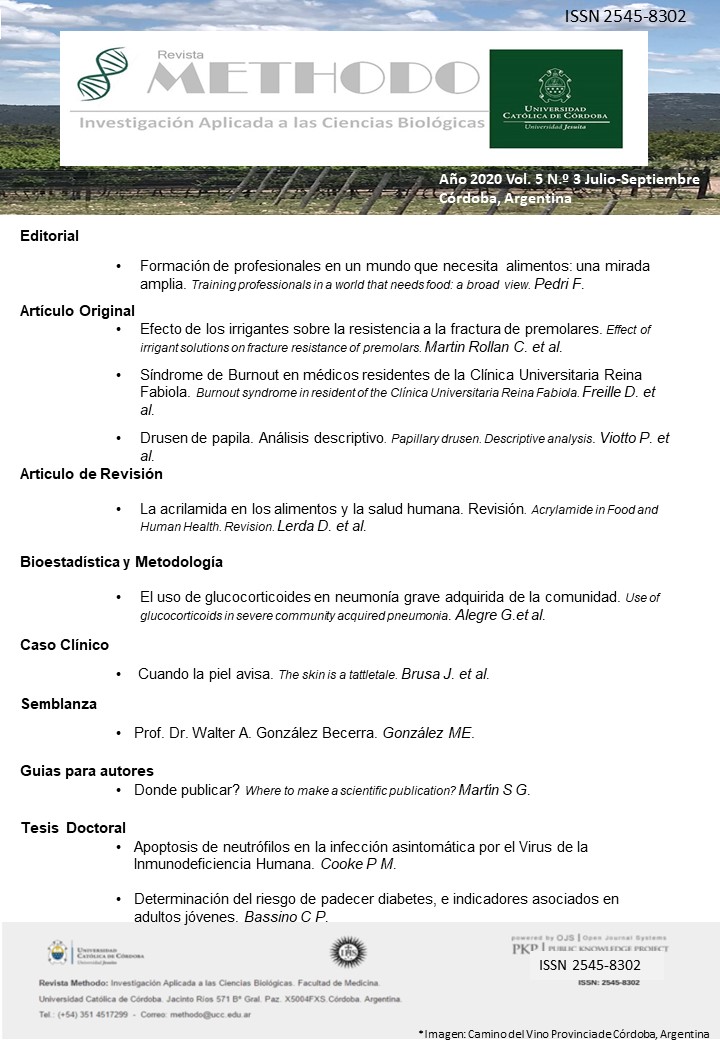Effect of irrigant solutions on fracture resistance of premolars
DOI:
https://doi.org/10.22529/me.2020.5(3)02Keywords:
bicuspid, therapeutic irrigation, EDTA, fracture strengh, regenerative endodontic.Abstract
INTRODUCTION: Regenerative endodontic procedures have been defined as biological procedures
designed to replace damaged structures including dentin and radicular structures, as well as cells of the
dentin complex, with vital tissue. They are considered as an alternative for treatment immature permanent
teeth with necrotic pulp. The clinical procedure is based in disinfection and subsequent a blood clot
formation in the root canal. Sodium hypochlorite (NaOCL) and EDTA are irrigation solutions frequently
used not only for disinfection but also for dentin conditioning, in order to release growth factors from dentin
matrix to guide stem cells differentiation. The hypothesis of the present study is that final irrigation of root
canal with EDTA decreases fracture resistance in immature human teeth.
OBJECTIVE: Evaluate the effect of irrigation with EDTA on the fracture resistance of premolars with open
foramen, previously irrigated with sodium hypochlorite.
MATERIALS AND METHODS: Ten pairs of healthy human premolars were selected, extracted for
orthodontic reasons. They were photographed and preoperative radiograph were taken. The access cavity
was performed, root canals were instrumented and Peeso drills were used to simulate immature teeth. The
external surfaces of the root were covered with teflon band to simulate a periodontal ligament. The twenty
teeth were randomly assigned into two groups of ten premolars each (n=10). Group A (control) was
irrigated with NaOCL 2.5% and group B (experimental) was irrigated with NaOCL 2.5% followed by 17%
EDTA. The access cavity was sealed with Biodentine and the crown was sectioned 3 mm coronal to the
CEJ. Samples were mounted in a composite resin, in order to keep them up perpendicularly to support base,
placed in an Instron testing machine (InstronCorp, Canton, MA, USA). By displacement of the machine’s
head, a metal cone produced a wedge effect on the root. The compressive force necessary to result in root
fracture was determined with a head speed displacement of 1mm per min. The force required to root fracture
was registered as Newton values. Data was statistically analyzed by using T test (P<0,05).
RESULTS: The force required to fracture the roots of premolars irrigated with NaOCl was of 337,84
Newton (mean value); while in the group irrigated with NaOCl followed by EDTA was of 345,54 Newton.
The difference was not statistically significant when comparing both groups by the t test (p> 0.05).
CONCLUSION: The final irrigation with EDTA did not reduce fracture resistance of premolars with
immature apex, previously irrigated with 2.5% sodium hypochlorite.
Published
Versions
- 2020-07-04 (2)
- 2020-07-03 (1)
How to Cite
Issue
Section
License
Copyright (c) 2020 Revista Methodo

This work is licensed under a Creative Commons Attribution-NonCommercial-ShareAlike 4.0 International License.




















